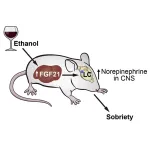(Press-News.org) BIRMINGHAM, Ala. – A United States Food and Drug Administration mandate to limit the dosage of acetaminophen in pills that combine acetaminophen and opioid medications is significantly associated with subsequent reductions in serious liver injury, researchers report in the medical journal JAMA. The federal mandate was announced in 2011 and implemented in 2014.
“The FDA mandate that limits acetaminophen dosage to 325 milligrams per tablet in combination acetaminophen-opioid medications was associated with a significant and persistent decline in the yearly rate of hospitalizations and proportion per year of acute liver failure cases involving acetaminophen and opioid toxicity,” said study leader and University of Alabama at Birmingham surgeon-scientist Jayme Locke, M.D. At UAB, Locke directs the Comprehensive Transplant Institute in the Marnix E. Heersink School of Medicine.
Patient safety — while still providing pain relief — is the reason to combine different analgesic classes in a medication. Together, the multiple drugs should provide additive synergistic analgesia while minimizing toxicity by using lower doses of each component.
The challenge was that too-high doses of acetaminophen, also known as paracetamol, are toxic to the liver. By 2005, one study found that 43 percent of acetaminophen-induced acute liver failure cases involved combination acetaminophen-opioid medications taken as therapy. So, an FDA advisory panel in 2009 recommended prohibiting sale of the combo acetaminophen-opioid medications, though the FDA instead acted to limit the dose of acetaminophen in those combination acetaminophen-opioid medications to 325 milligrams. Before the FDA mandate, such medications contained 325 to 750 milligrams of acetaminophen.
To examine the effect of this change, researchers in the JAMA study looked at yearly rates of hospitalization and acute liver failure cases in two independent, contemporaneous data sources, the National Inpatient Sample, or NIS, and the Acute Liver Failure Study Group, or ALFSG. The NIS is a very large U.S. hospitalization database with more than 473 million hospitalizations from 2007 to 2019. The ALFSG is a prospective, 32 U.S. medical-center cohort of adult patients with acute liver failure from 1998 to 2019.
In each data source, Locke and colleagues found similar declines in the yearly rates of hospitalization and acute liver failure cases associated with acetaminophen-opioid medications after the mandate. They also compared toxicity seen from acetaminophen-opioid medications versus toxicity from acetaminophen alone. In contrast to the declines from acetaminophen-opioid medications after the mandate, rates of hospitalization and acute liver failure cases associated with acetaminophen alone — where the dosage is not constrained by the FDA — continued to rise after the combination drug mandate.
The detailed results looked at four groups: NIS acetaminophen-opioid toxicity, NIS acetaminophen-alone toxicity, ALFSG acetaminophen-opioid toxicity and ALFSG acetaminophen-alone toxicity. Three different time frame analyses were done for each group: 1) before and after the FDA announcement date in 2011, 2) before and after the FDA implementation date in 2014, and 3) a washout comparison of cases before the 2011 announcement date and after the 2013 implementation date.
As an example of detailed findings, in the NIS group, the predicted incidence of hospitalizations associated with acetaminophen-opioid toxicity one day prior to the FDA announcement was 12.2 cases per 100,000 hospitalizations. By Q4 2019, it was 4.4 cases per 100,000 hospitalizations. The odds of a hospitalization involving acetaminophen-opioid toxicity increased 11 percent per year before the announcement and decreased 11 percent per year after the announcement.
In the ALFSG group, the predicted percentage of acute liver failure cases from acetaminophen-opioid toxicity one day prior to the FDA announcement was 27.4 percent. By Q3 2019, it was 5.3 percent. The percentage of acute liver failure cases involving acetaminophen-opioid toxicity increased 7 percent per year before the announcement and decreased 16 percent a year after the announcement.
The NIS database included 39,606 cases of hospitalizations involving acetaminophen-opioid toxicity, and the ALFSG database had 2,631 patients hospitalized with acute liver failure, including 465 with acetaminophen-opioid toxicity.
The authors caution that the study shows association, not causality. The changes in hospitalizations could also have come from increased public awareness and stiffer label warnings required by the FDA as part of the mandate, or changes in clinician prescribing patterns. However, in Canada, changes in labeling without an accompanying limit in the acetaminophen dosage was not associated with a decline in hospitalizations.
Locke is a professor in the UAB Department of Surgery, chief of the Division of Transplantation, and she holds the Arnold G. Diethelm Endowed Chair in Transplantation Surgery. First author in the JAMA study, Babak Orandi, M.D., Ph.D., is a visiting assistant professor of surgery at the UAB Heersink School of Medicine, and is currently an obesity medicine fellow and an instructor in medicine at Weill Cornell Medicine, and an assistant attending physician at NewYork-Presbyterian/Weill Cornell Medical Center, New York, New York.
Co-authors with Locke and Orandi are M. Chandler McLeod and Paul A. MacLennan, UAB Department of Surgery; William M. Lee, University of Texas Southwestern Medical Center, Dallas; Robert J. Fontana, University of Michigan Medical School, Ann Arbor; Constantine J. Karvellas, University of Alberta School of Medicine, Edmonton, Canada; Brendan M. McGuire, UAB Department of Medicine, Division of Gastroenterology and Hepatology; Cora E. Lewis, UAB School of Public Health, Department of Epidemiology; and Norah M. Terrault, University of Southern California Keck School of Medicine, Los Angeles.
Support came from National Institutes of Health grant DK58369, National Center for Advancing Translational Sciences grant TR003097 and a Society for Surgery of the Alimentary Tract Career Development Award.
About UAB
Known for its innovative and interdisciplinary approach to education at both the graduate and undergraduate levels, the University of Alabama at Birmingham, a part of the University of Alabama System, is an internationally renowned research university and academic medical center with over $700 million in research awards annually, as well as Alabama’s largest single employer, with some 28,000 employees, and has an annual economic impact exceeding $12.1 billion on the state. The pillars of UAB’s mission include education, research, innovation and economic development, community engagement, and patient care. Learn more at www.uab.edu.
About the UAB Heersink School of Medicine
With more than 800 medical students and a faculty of more than 1,200, the Heersink School of Medicine at the University of Alabama at Birmingham, a part of the University of Alabama System, is one of the premier academic medical centers in the United States. UAB is among the top 20 schools in research funding from the National Institutes of Health and is routinely listed among the best in various national rankings. UAB’s Medical-Scientist Training Program (M.D.-Ph.D.), Rural Medical Scholars Program and Early Medical School Acceptance Program are a few of the innovations on campus that foster collaboration across a multitude of disciplines. As the educational arm of UAB Medicine, the school trains students and residents in a world-class setting; UAB Hospital’s 1,200 beds place it among the largest hospitals in the country. Doctoral students in UAB’s Graduate Biomedical Sciences Program participate in interdisciplinary thematic programs that integrate more than 25 departments and 20 research centers across UAB. Learn more at www.uab.edu.
END
FDA mandate to limit acetaminophen in acetaminophen-opioid medications is associated with reduced serious liver injury
The federal mandate, which was announced in 2011 and implemented in 2014, limited acetaminophen to 325 milligrams per opioid-acetaminophen combination pill. Acetaminophen is toxic to livers at high doses
2023-03-07
ELSE PRESS RELEASES FROM THIS DATE:
Elegantly modeling earth’s abrupt glacial transitions
2023-03-07
WASHINGTON, March 7, 2023 – Proxy data – indirect records of the Earth’s climate found in unlikely places like coral, pollen, trees, and sediments – show interesting oscillations approximately every 100,000 years starting about 1 million years ago. Strong changes in global ice volume, sea level, carbon dioxide concentration, and surface temperature indicate cycles of a long, slow transition to a glacial period and an abrupt switch to a warm and short interglacial period.
Milutin Milankovitch hypothesized that the timing of these cycles was controlled by the orbital parameters of the Earth, including the shape of its path around ...
Drunk mice sober up after a hormone shot
2023-03-07
A hormone called fibroblast growth factor 21 (FGF21) protects mice against ethanol-induced loss of balance and righting reflex, according to a study publishing on March 7 in the journal Cell Metabolism.
“We’ve discovered that the liver is not only involved in metabolizing alcohol but that it also sends a hormonal signal to the brain to protect against the harmful effects of intoxication, including both loss of consciousness and coordination,” says co-senior study author Steven Kliewer of the University of Texas Southwestern Medical Center.
“We’ve further shown that by increasing FGF21 concentrations even higher by injection, we can dramatically ...
The case for female mice in neuroscience research
2023-03-07
At a glance:
New research suggests female mice show more stable exploratory behavior than male mice, despite hormone cycles
The results challenge a long-held assumption that hormones have a broad effect on behavior in female mice, making them less suitable for research
The findings make a strong scientific case for increasing the inclusion of female mice in neuroscience and other experiments
Mice have long been a central part of neuroscience research, providing a flexible model that scientists ...
Association of stress with cognitive function among older adults
2023-03-07
About The Study: This study of 24,000 participants age 45 or older found an independent association between perceived stress and both prevalent and incident cognitive impairment. The findings suggest the need for regular screening and targeted interventions for stress among older adults.
Authors: Ambar Kulshreshtha, M.D., Ph.D., of the Emory University School of Medicine in Atlanta, is the corresponding author.
To access the embargoed study: Visit our For The Media website at this link https://media.jamanetwork.com/
(doi:10.1001/jamanetworkopen.2023.1860)
Editor’s ...
Telemedicine use by rural vs urban VA beneficiaries before, after onset COVID-19
2023-03-07
About The Study: The findings of this study suggest that despite initial telemedicine gains at rural Veterans Affairs (VA) health care sites, the pandemic was associated with an increase in the rural-urban telemedicine divide across the VA health care system. To ensure equitable access to care, the VA health care system’s coordinated telemedicine response may benefit from addressing rural disparities in structural capacity (e.g., internet bandwidth) and from tailoring technology to encourage adoption among rural users.
Authors: Lucinda B. Leung, M.D., Ph.D., M.P.H., of the Veterans Affairs Greater Los Angeles Healthcare System in Los Angeles, is the corresponding ...
FDA rule lowering drug dose is associated with less liver injury
2023-03-07
A United States Food and Drug Administration mandate to limit the dosage of acetaminophen in pills that combine acetaminophen and opioid medications is significantly associated with subsequent reductions in serious liver injury, according to a study led by investigators at the University of Alabama and Weill Cornell Medicine. The federal mandate was announced in 2011 and implemented in 2014. The results were reported March 7 in the medical journal JAMA.
“After researchers found that more than 40 percent of acetaminophen-induced acute liver failure cases involved combination acetaminophen and opioid medications, and an FDA advisory ...
Counting heads: how deep learning can simplify tedious agricultural tasks
2023-03-07
The selective breeding of grain crops is one of the main reasons why domesticated plants produce such excellent yields. Selecting the best candidates for breeding is, however, a remarkably complex task. On one hand, it requires a skilled breeder with trained eyes to assess plant resistance to disease and pests, crop growth, and other factors. On the other hand, it also requires precise tool-assisted measurements such as grain size, mass, and quality.
Although all these standard measures are useful, none of them takes into account the number ...
Evidence for the health benefits of consuming more live microbes
2023-03-07
Safe live microorganisms are found in a variety of foods we eat every day, from yogurt and other fermented foods, to raw fruits and vegetables. Despite the widespread idea that these mixtures of live microbes contribute to health, convincing evidence linking live dietary microbes to health benefits has been lacking.
A new study provides some of the first real-world evidence that higher consumption of live microbes may promote health. A group of scientists led by the International Scientific Association for Probiotics and Prebiotics (ISAPP) classified over 9,000 individual ...
IVI launches global study to determine the burden of HPV among girls and women
2023-03-07
The International Vaccine Institute (IVI), an international organization with a mission to discover, develop, and deliver safe, effective, and affordable vaccines for global health, announced the start of a multi-country study to better understand the burden of Human papillomavirus (HPV) among girls and women in low- and lower middle-income countries. This study received $14.99 million USD in funding from the Bill & Melinda Gates Foundation with $1 million USD co-funding from the Swedish government and will help inform intervention implementation and prioritization of research and development efforts that have the greatest potential public health ...
Novel porous materials are ideal for metal-air batteries, researchers report
2023-03-07
Sustainable energy solutions cannot be pulled out of thin air. However, combining air with metal and other frameworks may pave the way for environmentally friendly energy conversion and storage, according to a research team based in China.
They published their review of novel porous materials — called metal-organic frameworks (MOFs) and covalent organic frameworks (COFs) — and their potential to advance metal-air batteries on 03 March in Nano Research Energy.
The porous crystal material frameworks comprise various arrangements of bonded materials that can induce desired properties, including the ability to accelerate reactions between oxygen and metals ...
LAST 30 PRESS RELEASES:
University of Oklahoma researcher awarded funding to pursue AI-powered material design
Exploring how the visual system recovers following injury
Support for parents with infants at pediatric check-ups leads to better reading and math skills in elementary school
Kids’ behavioral health is a growing share of family health costs
Day & night: Cancer disrupts the brain’s natural rhythm
COVID-19 vaccination significantly reduces risk to pregnant women and baby
The role of vaccination in maternal and perinatal outcomes associated with COVID-19 in pregnancy
Mayo Clinic smartwatch system helps parents shorten and defuse children's severe tantrums early
Behavioral health spending spikes to 40% of all children’s health expenditures, nearly doubling in a decade
Digital cognitive behavioral treatment for generalized anxiety disorder
Expenditures for pediatric behavioral health care over time and estimated family financial burden
Air conditioning in nursing homes and mortality during extreme heat
The Alps to lose a record number of glaciers in the next decade
What makes a good proton conductor?
New science reporting guide published for journalists in Bulgaria
New international study reveals major survival gaps among children with cancer
New science reporting guide published for journalists in Turkey
Scientists develop a smarter mRNA therapy that knows which cells to target
Neuroanatomy-informed brain–machine hybrid intelligence for robust acoustic target detection
Eight SwRI hydrogen projects funded by ENERGYWERX
The Lundquist Institute and its start-up company Vitalex Biosciences Announces Strategic Advancement of Second-Generation fungal Vaccine VXV-01 through Phase 1 Trials under $40 Million Competitive Con
Fine particles in pollution are associated with early signs of autoimmune disease
Review article | Towards a Global Ground-Based Earth Observatory (GGBEO): Leveraging existing systems and networks
Penn and UMich create world’s smallest programmable, autonomous robots
Cleveland researchers launch first major study to address ‘hidden performance killer’ in athletes
To connect across politics, try saying what you oppose
Modulating key interaction prevents virus from entering cells
Project explores barriers to NHS career progression facing international medical graduates
Jeonbuk National University researchers explore the impact of different seasonings on the flavor perception of Doenjang soup
Two Keck Medicine of USC Hospitals named Leapfrog Top Teaching Hospitals
[Press-News.org] FDA mandate to limit acetaminophen in acetaminophen-opioid medications is associated with reduced serious liver injuryThe federal mandate, which was announced in 2011 and implemented in 2014, limited acetaminophen to 325 milligrams per opioid-acetaminophen combination pill. Acetaminophen is toxic to livers at high doses


